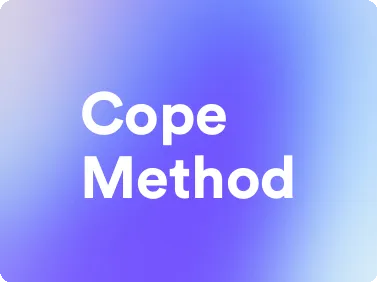The Cope Method: A Productivity Technique
This guide will walk you through the essential elements of using cope method - the productivity method to keep your team productive and engaged.
Try Lark for Free
In today's fast-paced world, effective time management and productivity techniques are essential for maintaining a healthy work-life balance. One such method that has gained popularity is the Cope Method. This article will delve into the origin of the Cope Method, its application, and provide a detailed step-by-step guide to help individuals maximize their productivity.
What is the Cope Method in the Context of Productivity?
The Cope Method is a productivity approach designed to help individuals prioritize tasks based on their importance and urgency. It provides a framework for managing time efficiently by categorizing tasks into specific quadrants, allowing individuals to focus on activities that align with their goals and objectives. This method aims to minimize stress and increase productivity by promoting a balance between work and personal life.
Understanding the Cope Method involves recognizing the significance of different tasks and allocating time and resources accordingly. By implementing this approach, individuals can effectively address pressing matters while also making time for long-term goals and personal well-being.
What is the Origin of the Cope Method?
The Cope Method, also known as the Eisenhower Matrix, was popularized by former U.S. President Dwight D. Eisenhower. He was known for his exceptional ability to manage time and responsibilities, attributing his success to a simple yet powerful productivity strategy. The concept was further developed by productivity experts to create a practical framework for individuals to organize their tasks and increase efficiency in their daily lives.
Use Lark to unleash your team productivity.
Who is the Cope Method For?
The Cope Method is suitable for individuals from all walks of life who seek to enhance their time management skills and improve productivity. Whether you are a professional striving to excel in your career, a student managing academic obligations, or someone looking to maintain a balanced lifestyle, the Cope Method offers a versatile and adaptable approach to task prioritization and productivity enhancement.
Notable Characteristics of Cope Method Users
- Professionals aiming to streamline their workflow
- Students seeking effective time management during studies
- Individuals striving for a balanced and organized lifestyle
What are the Pros and Cons of the Cope Method?
Pros of the Cope Method
- Effective Prioritization: By categorizing tasks into quadrants, individuals can clearly identify priorities.
- Enhanced Productivity: Ensures focus on tasks that contribute to long-term goals, leading to increased efficiency.
- Reduced Stress: Provides a structured approach to managing responsibilities, reducing anxiety and overwhelm.
Cons of the Cope Method
- Potential Overemphasis on Urgency: Some individuals may prioritize tasks solely based on urgency, neglecting important but non-urgent activities.
- Adaptation Challenges: It might take time and effort to fully integrate the method into one's routine, leading to initial resistance.
- Flexibility Concerns: Striving for strict adherence to the method may hinder spontaneous or creative pursuits.
Learn more about Lark x Productivity
How to Get Started with the Cope Method
Getting started with the Cope Method involves understanding its core principles and implementing them effectively. Follow these steps to begin integrating this productivity technique into your daily routine:
- Grasp the Quadrants: Familiarize yourself with the four quadrants of the Cope Method, which include Important and Urgent, Important but Not Urgent, Urgent but Not Important, and Neither Important nor Urgent.
- Task Assessment: Evaluate your current tasks and responsibilities to determine their placement within the quadrants.
- Strategic Planning: Plan your daily, weekly, or monthly schedules by allocating time for activities based on the quadrant they belong to.
- Adapt and Adjust: Continuously assess and reorganize tasks as priorities shift, ensuring ongoing alignment with your objectives.
Use Lark to unleash your team productivity.
Actionable Tips for the Cope Method
Implementing the Cope Method effectively requires mindful application and continuous refinement. Consider the following actionable tips to optimize your utilization of this productivity technique:
- Regular Review: Consistently review and reassess task placement within the quadrants to maintain relevance and accuracy.
- Balanced Allocation: Strive for a balanced distribution of important but not urgent tasks to foster long-term growth and development.
- Flexibility: Allow for flexibility within the method to accommodate unexpected opportunities or changes in priorities.
- Delegate Appropriately: Identify tasks that can be delegated to others without sacrificing quality or efficiency.
Do's and Dont's
The table below presents a comprehensive list of recommended practices (Do's) and actions to avoid (Dont's) when applying the Cope Method:
| Do's | Dont's |
|---|---|
| Prioritize significant projects and goals | Procrastinate on important but non-urgent tasks |
| Regularly reassess task priorities | Overwhelm yourself with unnecessary urgency |
| Allocate time for personal growth | Neglect long-term developmental activities |
| Seek balance between work and leisure | Disregard the importance of relaxation and rest |
Conclusion
In conclusion, the Cope Method offers an effective framework for individuals seeking to optimize their time management and enhance productivity. By categorizing tasks into distinct quadrants and prioritizing based on importance and urgency, individuals can navigate their responsibilities with greater clarity and purpose. Embracing the Cope Method empowers individuals to achieve a harmonious balance between professional obligations, personal development, and overall well-being.
Use Lark to unleash your team productivity.
